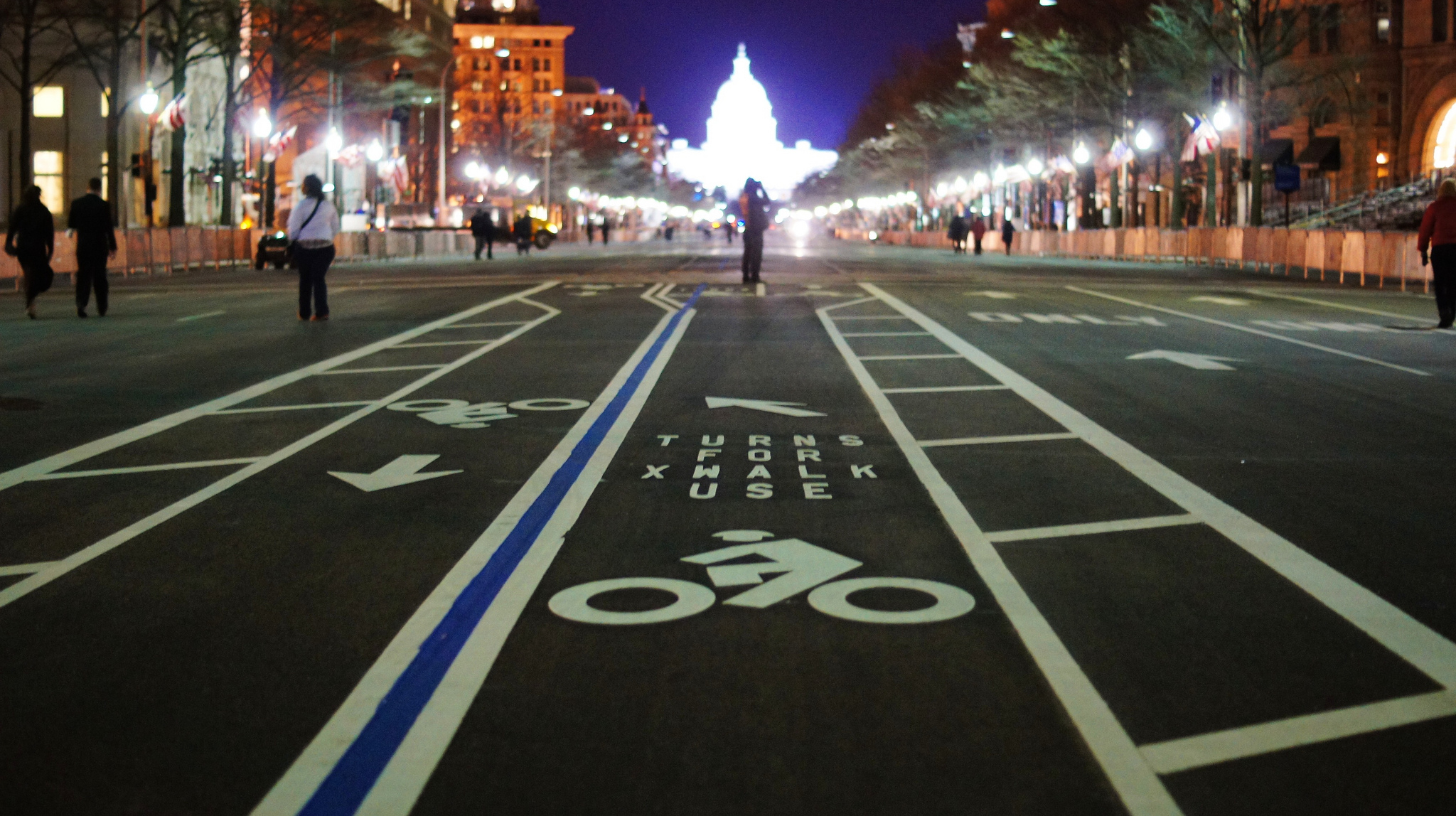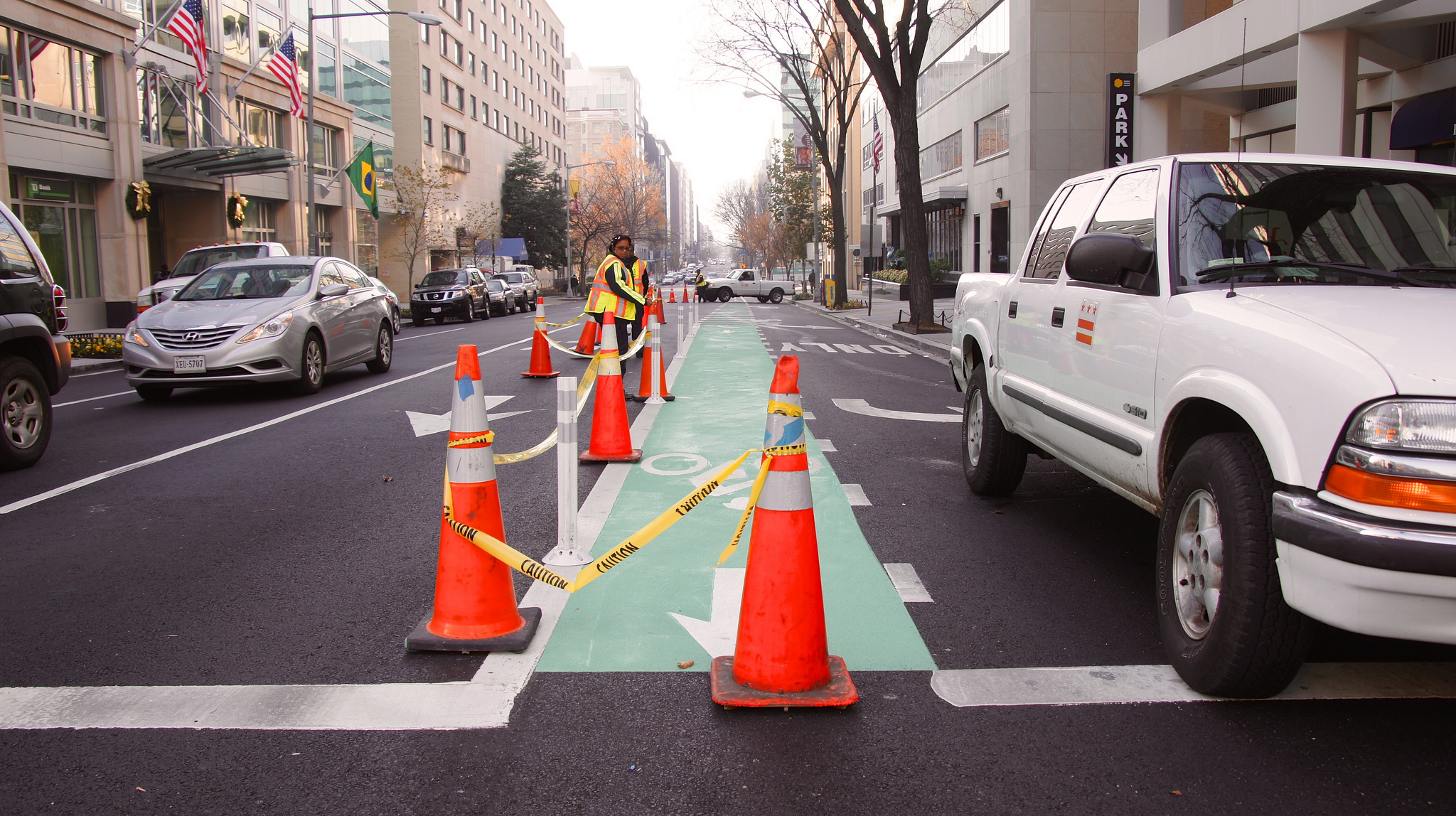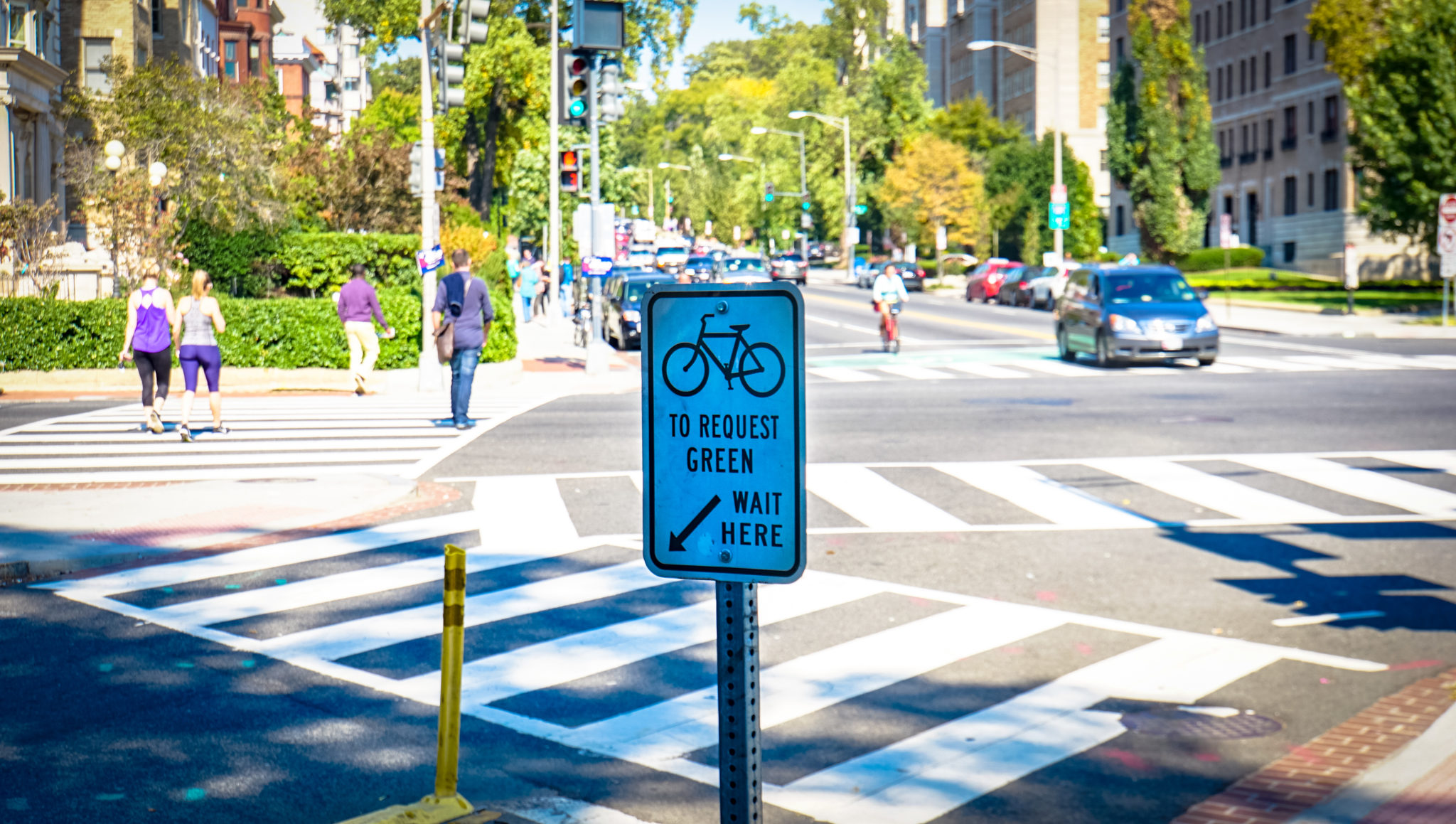D.C. wants more people on buses and bicycles. But it needs to pick up the pace on its projects to get there.
Washington, D.C. needs to improve its planning to build bus and bike lanes faster. The benefits of bus and bike lanes are realized only when the network of bus and bike lanes is complete.
The city already has the policies and laws on the books to make this happen. Unfortunately, the current planning process is too prone to delays. Those delays are from inefficiency in project planning and the politicization of individual bus and bike lanes. To get the work done faster, the city’s planning and execution has to improve.
D.C. already has the framework it needs to reshape its transportation system
Complete Streets, MoveDC, and Vision Zero are the cornerstones of Washington, D.C.’s goal to reduce congestion and improve safety. With these policies, the city has the legal and policy framework to reshape the city’s transportation system:
- D.C.’s Complete Streets Policy ensures that planning efforts for any street project in the District consider everybody, including pedestrians, cyclists, transit users, and drivers.
- MoveDC’s efforts started in 2013 and build off the work of 2010’s Complete Streets Policy. MoveDC is the plan developed by DDOT to help guide the future of transportation in D.C. Focused on all aspects of mobility, the plan emphasizes two goals in particular: First, to have at least 75 percent of trips taken by means other than driving alone; and second, to have a major transit, bicycle, or pedestrian improvement on each major street in the city.
- Finally, Vision Zero, passed in 2016 is the city’s effort to get serious about traffic safety and to eliminate traffic deaths in the city by the year 2024.
All three of these policies are an important step that recognizes the need for Washington to build on its successes in cycling and transit usage. Together they create a vision of transportation in D.C. that is safe and able to move people quickly despite heavy congestion. With that goal in mind DDOT is empowered to be bold about its plans for city streets.

Pennsylvania Avenue bike lanes in 2013. Photo by Ted Eytan.
Bus lanes and bike lanes are small projects with big impacts
The beauty of bus and bike lanes is that they leverage existing infrastructure (i.e., roads) and allocate space more efficiently. That can help the city meet its goals of moving more people in fewer cars while keeping costs down. No individual bus or bike lane will transform the city entirely, but the cumulative effect of a number of projects can improve the city’s transportation landscape for little cost.
But the city needs to paint its bus and bike lanes faster to have any hope of meeting its ambitious but reachable goals for increased cycling and public transportation usage. To speed up and expand the city’s bus and bike lane network, D.C. needs to:
- Treat bus and bike lanes as part of routine maintenance, not new capital projects
- Proactively address residents’ traffic and parking concerns when new projects are announced
1. Treat bus lanes and bike lanes like you would a pothole and not a new capital project.
The capital funding process is a major hindrance to creating new bus and bike lanes. When each bus or bike lane is treated as its own capital project needing a full design review, that means the full network of bus and bike lanes is that much further from completion. However, most bus and bike lane projects usually require only a fraction of the materials that bigger road or rail projects require. This means changes can happen quickly, without the need for an intense planning process.
One approach that other jurisdictions have successfully employed is to treat these low-cost, low-construction impact projects as part of regular street maintenance instead of new capital projects. Thanks to objectives set out in D.C.’s Complete Streets Policy, the city can ensure any plans related to city streets take into account all users and replace what is missing—even if what is missing is a safe bike lane, or a bus lane that can help move more people on public transportation.
Fairfax County has a similar initiative when it comes to bike lanes. Each year as a part of its road repaving program, the county identifies roads that are due for regular repaving that could support bike lanes. Those bike lanes are added once the repaving is complete as the road is being repainted.
Fairfax still conducts public meetings in neighborhoods where bike lanes are slated to be built. This gives residents a chance to weigh in on concerns about traffic or parking. It has still led to the delay or cancellation of some bike lanes in the county, but on balance the program has allowed Fairfax County’s bike lane mileage to expand dramatically. Most of the county’s 140 miles of bike lanes are due to its summer repaving program, which began in earnest only a few years ago—all at virtually zero cost, thanks to coordination with the already-existing road-maintenance schedules.
One major difference between D.C. and Fairfax is that Fairfax used this approach to build out its “easy” network of bike lanes (i.e., bike lanes that can be painted with little impact to parking or throughput on a roadway), and D.C. has mostly painted all of its “easy” bus and bike lanes already. But Fairfax can still serve as a successful precedent in thinking of bus and bike lanes as a maintenance projects rather than capital projects.
DDOT should therefore create a rapid expansion plan that would let the agency quickly paint and install the necessary infrastructure as a part of a street’s regular maintenance schedule. (This would be most successful with local streets that are paid for fully by District funds, which would have fewer hurdles to clear than major roads that receive federal dollars.) Doing so is backed by the city’s Complete Streets Policy and MoveDC’s goal of bus or bike lanes on a majority of D.C. streets.
If reclassifying bus and bike lanes as maintenance instead of capital projects isn’t an option, the city should look into its capital financing plans and look for improvements to streamline projects, such as working on a rapid expansion plan that would spend time upfront designing facilities for a large area rather than a specific corridor.
The city also needs to be more open to experimenting. For instance, D.C. should just set up temporary bus and bike lanes on city streets with cones and traffic control officers and see what happens when more space is given to buses and bicycles. Experiments can remove a lot of uncertainty in project planning that can stall a project, particularly when opposition is built on assumptions that can be tested.
The city should also work to standardize the processes that it can so that projects can be designed and built quickly. Additionally, the city should review the transit and bike lane related sections of its design-build standards to find opportunities to shorten timelines.
When the city can point to real data that shows benefits from a project, it becomes harder to argue against a project’s supposed demerits. The results can also turn skeptics into supporters when they get a chance to simply see how things work in the real world.
Finally, experiments are meant to be done quickly and cheaply, which means that when it becomes time to make any changes permanent, the project can be streamlined that much further. It is true that not every experiment may be a success, but a risk-averse mindset also means the city will be forever stuck with an incredibly slow process in building out its transit and bike lane network.
2. Proactively address residents’ traffic and parking concerns when new projects are announced
By far the largest threat to any bus or bike lane project is fear over a project’s impact on traffic congestion and parking. Political opposition can organize quickly (uniting even churches and strip clubs) and quickly morph beyond the mundane traffic impacts and lead to claims that the city is infringing on religious freedoms.
Concerns that bus and bike lanes would increase travel times for cars can be addressed with better outreach. DDOT already has the data it needs to show that bus and bike lanes can be successfully implemented without harming drivers. For instance, the installation of the city’s existing bike lanes helped more than double the number of cyclists in the city in the past ten years. Meanwhile, vehicle travel times barely budged despite losing a travel lane.
DDOT could have information about the positive travel and economic impacts of existing projects available at every public meeting about transit or bike lanes. DDOT could also improve its outreach by creating online materials that address common arguments against bus and bike lanes in a D.C.-specific context.
The potential loss of parking is a thornier issue because its impact (and therefore its opposition) is more local. The best solution is for the city to come up with better management for on-street parking. That means finding ways to end the large subsidies needed for the city’s current street parking rules that distort everything else when it comes to transportation policy in Washington D.C.
In some cases, such as with diagonal parking, existing parking spots have been removed to widen curbs or install bike lanes. But there could be corridors where diagonal parking could be preserved or added at the expense of a travel lane. It would bring the benefit of traffic calming to roads beyond the transit or bike lanes. That in turn could help the city meet its Complete Streets and Vision Zero goals in more ways than one.
It is not a solution that can happen every time, and when it cannot, the city needs to stick to its principles in making transportation safer and more sustainable. However, the willingness to at least consider increasing parking in some cases would show flexibility on the city’s part to work with all stakeholders in transit and bike lane projects.

The new L Street bike path in 2012. Photo by Ted Eytan.
These changes can make small wins possible in the short-term, but we need to change the broader conversation.
The measures outlined above are practical ideas, but do not really address the biggest reason for most of the delays in building bus and bike lanes: politics. Politics rears its head during the community engagement process, when a few vocal individuals—with enough time and resources—can hold up projects that would improve safety for an entire community. Politics comes into play when negative perceptions about a project’s effects become entrenched, and form a rallying cry for people who may not see an immediate benefit to a change in the current transportation landscape.
Worse, politics gets in the way even when the city has the necessary data and legal backing to make big changes. Most city officials don’t want to expend political capital on a bus lane; why go to bat for a single bike lane when people angrily complain about lost parking spots? Inaction is by far the easiest course.
Changing the conversation about how we use our city’s streets is vital, and there are no quick fixes—a topic for another article. But in the meantime, the city can work to streamline current processes and remove obstacles to creating a comprehensive transit and bike lane network.
Canaan Merchant is a graduate of George Mason University. He has a passion for public transportation and urban planning and writes frequently for Greater Greater Washington. Canaan has worked for a variety of federal agencies including the U.S. Treasury, Consumer Financial Protection Bureau, Department of Transportation, and Homeland Security.
